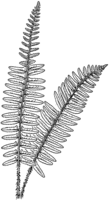 | Back to e-WV
| Back to e-WV
 The West Virginia Encyclopedia
The West Virginia Encyclopedia
 | Back to e-WV
| Back to e-WV
 The West Virginia Encyclopedia
The West Virginia Encyclopedia

West Virginia’s 87 species of ferns occupy many natural habitats throughout the state. Ferns play an important role in the understory of both coniferous and deciduous woods. Though more prominently residents of moist-shady forests, ferns inhabit environments as divergent as peat bogs and the exposed faces of cliffs. Their delicate forms and textures add grace and beauty wherever they grow.
Most of our ferns are perennial, herbaceous plants. A few species are evergreen, such as Christmas fern. Christmas fern is found abundantly throughout West Virginia in the understory of various forest types. Its evergreen leaves have been used since Colonial times as an indoor decoration during the Christmas holidays.
Unlike flowering plants, ferns reproduce by producing microscopic spores on the undersides of their leaves, or, in the case of a few species, on separate spore-bearing stalks. Circular clusters of the elegant, six-to-seven-foot wands of cinnamon fern splay like fountains across wetland areas or on the periphery of lakes and streams. The spores are produced on large, cinnamon-colored stalks which usually grow within the center of the clustered leaves.
Each spring, new fern leaves emerge from the ground in a coiled spiral called a fiddle-head. Fern leaves unfurl gradually both laterally and vertically as they grow. The young fiddle-heads of several species of ferns are edible. They may be eaten raw, tossed into salads, or cooked in a little water and butter. The flavor is similar to that of asparagus.
Some of the more unusual types of ferns include climbing fern, filmy fern, rusty woodsia, Goldie’s shield fern, and adder’s tongue fern. Climbing fern sends its wiry, three-to-four-foot stem across vegetation in glade-like habitats. Each little leaf is shaped somewhat like the palm of a hand. Rusty woodsia is found as far north as the Arctic. The delicate little filmy fern has close relatives in the tropics.
Written by Emily Grafton